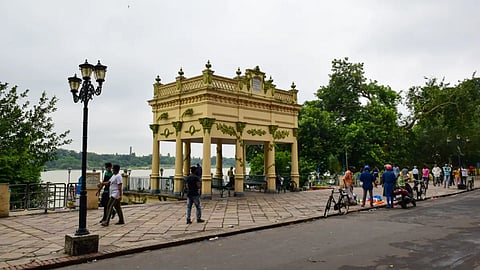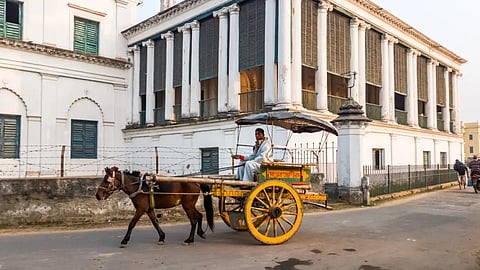A DUTCH TRAIL IN SREERAMPUR
5 Ways To Explore Bengal On The River Hooghly
All along the Hooghly river are ports that were once used by the Dutch, English, Portuguese, and French as centres of a once thriving trade. One of the best ways to explore some of these settlements is through the various cruises and ferries run by the state tourism department, or via a luxury cruise service. Here are five destinations to map on the Hooghly
This town was known as Frederiksnagore after King Fredric VI of Denmark. The Danes came here in 1616, and later the East India Company took over. Recently, a joint initiative by the West Bengal Heritage Commission and the the National Museum of Denmark restored the 215-year-old St Olav’s Church which has a royal monogram of Danish king Christian VII. The first printing press in Bengal was set up here (by Baptist missionary William Carey in 1800). The Serampore Mission Press produced 212,000 books between 1800 and 1832! It served print markets in the South and South-East Asia as well as those outside Europe in the 19th century publishing many religious Christian texts, literary works from India, translations of the Bible and vernacular textbooks on grammar, dictionaries, history, legends and moral tales for the Fort William College and the Calcutta School Book Society. It was from here that the first Bengali newspaper and magazine was published in 1818.
A TOUCH OF FRANCE IN CHANDANNAGAR

You will find traces of a French past in Chandannagar in the strangest of things - like the four-poster bed that governor Joseph Franois Dupleix left behind. When you take a stroll down the Strand, you will find it the riverfront studded with colonial buildings. The Chandannagar Museum and Indo-French Institute, which used to be Dupleix’s mansion, houses an interesting collection of French artefacts and a French language school. In front of the museum is an elegant mansion called the Patal Bari (underground house), named so because a part of the house lies under the river. Did you know that Chandannagar is also known as the city of lights? The light makers here are famous for the illuminated panels that you see on the streets of Kolkata during Durga Puja. Artists stitch thousands of multi-coloured bulbs on wire frames, creating a tableau of images - from moving vehicles to fire-spitting dragons and even celebrities. These artists have been invited to display their art world over and at the Thames Festival in London (2003), the talk of the city was the giant, brilliantly lit, peacock-shaped boat they made using over 120,000 micro bulbs.
THE MOORS IN MURSHIDABAD

Murshidabad was once the capital of Bengal under Siraj-ud- daula, the nawab of Bengal, who was assassinated here after a defeat by Robert Clive at Plassey (Palashi) in 1757. The spectacular old structures reflect those days of glory. Probably the most jaw-dropping is Hazarduari, named after its 1,000 doors. Built in 1837, it was home to the nawabs of Murshidabad. Today it is a museum, housing an interesting collection of antiquities. The armoury galleries on the ground floor stock a variety of firearms and swords from that era, and an ivory sedan chair which was used by emperor Shah Jahan.
The library has more than 10,000 books and thousands of old manuscripts, including an early copy of the legendary Ain-i- Akbari! Don’t leave without seeing the Katra Masjid, the tomb of Murshid Quli Khan after whom Murshidabad is named. This remarkable man lies buried in the basement under the stairs. He was born a Deccan Brahmin, was sold to a Muslim merchant, and subsequently became the governor of Bengal and founded Murshidabad.
A PORTUGUESE PAST IN BANDEL
About 49 km north of Kolkata, Bandel was a Portuguese and Dutch outpost. The brown-and-white Bandel Basilica was built in 1599 by Portuguese captain Pedro Tavares, but it was burnt down by the Moors in 1632. You can see the past more strongly in the Victorian Imambara. Built in 1863, it has thousand arches that surround its old courtyard. The Hanseshwari Temple is weird yet a wonderful melange of Russian and local architectural styles with a dome that looks distinctly Kremlin-like. Bandel has a famous cheese named after the town. Introduced by the Portuguese, it is crumbly, smoky and quite salty. The small discs go well with green salads and pastas.
MULTICULTURAL HUES OF HOOGHLY
The 500-year-old town used to be a river port in the 15th century. It is located on the west bank of the Hooghly River, about 40 km north of Kolkata. The medieval kingdom of Bhurshut or Bhurisrestha was spread across the Hooghly district (and Howrah). It was also the first European settlement in Bengal. The first to reach this place were the Portuguese, and within a few decades this became the largest port in Bengal. Hooghly’s multi-cultured heritage is reflected in its monuments and structures.
The Hooghly Imambara (dating back to 1861) on the bank of the river has an imposing entrance with a clock tower flanked by 80 ft tall towers. Inside, texts from the Quran decorate the walls. The Taraknath temple, built in 1729, is a popular pilgrimage spot dedicated to the Hindu god Shiva. Incidentally, the district headquarters Chinsurah is where the national song Vande Mataram was composed by Bankim Chandra Chattopadhyay. The Armenian Church in Chinsurah is the second-oldest church in Bengal. There’s even a Dutch cemetery with interesting plaques, graves and obelisks. Look out for the remnants of Fort Gustavson built in 1628.